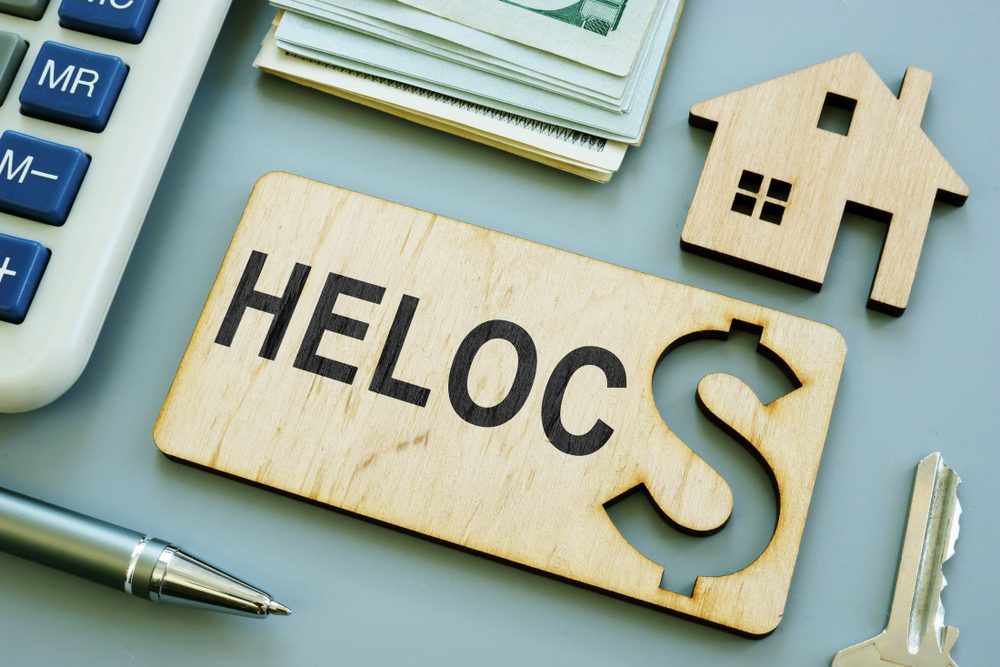Advertiser Disclosure: Many of the companies featured here provide compensation to us. This is how we maintain our free service for consumers. Compensation, along with hours of in-depth editorial research, determines where & how companies appear below.
A home equity line of credit (HELOC) can be an ideal alternative. But, the tax ramifications of both alternatives are more intricate than they once were. The interest on a HELOC may be tax deductible, subject to certain criteria.
There are two sorts of home equity loans: a fixed-rate loan for a predetermined amount and a line of credit with a variable interest rate. Based on your need for the finances and intended purpose, one alternative may be preferable to the other. Like the interest on your initial mortgage, interest paid on either loan is sometimes tax deductible.
The Key Takeaways
- The interest on a home equity line of credit (HELOC) or a home equity loan is tax deductible if the funds are used to “purchase, construct, or significantly renovate” the house.
- To be deductible, the funds must be spent on the property whose equity serves as the loan’s basis.
- Taxpayers are limited to deducting interest on residential loans totaling up to $750,000 (or $375,000 for married taxpayers filing separate returns), which includes all residential debt, including mortgages and home equity loans or HELOCs.
- Prior limits of $1 million (or $500,000 for a married taxpayer filing a separate return) may apply to older mortgages.
New Regulations For Deductions On House Equity
Since the tax legislation changed in 2017, the tax deductibility of interest on a HELOC or home equity loan is contingent on how the loan funds are used. This applies to interest on loans that existed before the new tax law as well as interest on new loans. Here is how it operates.
The interest on home equity debt is tax deductible if the funds are used to purchase, construct, or substantially improve the home.
In addition, the money must be spent on the property whose equity is the basis of the loan. If you qualify, you can deduct the interest on loans of up to $750,000 ($375,000 or more for married taxpayers filing separately).
Note that the new deduction maximum for all residential debt is $750,000. If you have a mortgage plus home equity debt, what you owe on the mortgage will also come under the $750,000 limit—if it’s a new mortgage. Older mortgages (before 2018) may be covered by the former $1 million limit (or $500,000 for a married couple filing separately).
This gives individuals who borrow for renovations more advantages than before. Before, interest was deductible on home equity loans up to $100,000. But, you received this deduction regardless of how you used the loan, such as to pay off credit card debt or fund education expenses.
Aware that the 2017 tax reforms increased the standard deduction to the point that it is no longer advantageous for many individuals to itemize their tax deductions, rendering HELOC and home equity loan interest deductions essentially obsolete. In 2022, the standard deduction for single filers is $12,950 and for married couples filing jointly it is $25,900, rising to $13,850 and $27,700 in 2023.
The interest paid on a HELOC or home equity loan is unlikely to be the determining factor between taking the standard deduction and itemizing expenses unless you have an extraordinarily large HELOC or home equity loan. If you currently itemize your deductions, it may make the most financial sense for you to choose a HELOC or home equity loan over a personal loan so that you can deduct the interest. Keep in mind that if loan rates rise, the desirability and deductibility of a HELOC may change.
How To Claim The Deduction For Home Equity Interest

If you own a property and intend to claim the home equity loan interest deduction, keep in mind the following:
First, the funds must be spent on home upgrades or enhancements. For example, you cannot use the deduction if you are utilizing home equity profits to pay for personal expenditures or to consolidate credit card debt. The same is true if you take out a loan and use the proceeds to fund your emergency fund. Also, the renovations must be completed on the property for which the home equity loan was obtained. You cannot, for example, take out a loan on your primary residence and use the money to refurbish your cottage at the lake.
Secondly, you must maintain accurate records of your costs. The likelihood of an Internal Revenue Service audit is normally low, but you should not take any chances. If you want to use a home equity loan or a home equity line of credit (HELOC) to pay for home repairs or improvements, be sure to save all receipts and bank statements documenting where the money went.
Lastly, keep in mind that this deduction is limited. If the loan was made after December 15, 2017, you may deduct the interest on up to $750,000 in mortgage debts. If your entire mortgage debt exceeds this threshold, you will not be able to deduct the total interest paid. Prior to that date, the $1 million limit applies to mortgages obtained.
While interest on older mortgages remains a legacy to $1 million loans, check carefully with your accountant about what you can deduct if you have both an older mortgage and a home equity loan that qualifies for deductions.
Added Advantages Of A HELOC
HELOC rates (and home equity loan rates) are just slightly higher than first mortgage rates, making HELOCs far more affordable than alternative borrowing options. Of course, whether a HELOC is a good deal or not can depend on the current interest rate situation. Typically, HELOC rates are determined by the prime rate, which is affected by the federal funds rate. If the Federal Reserve increases the federal funds rate, the prime rate and HELOC rates may increase as well.
Getting a HELOC also means that you only borrow as much as you need—not a lump sum, as is the case with a home equity loan. This allows you to only pay interest on the amount of your credit line that you use, which might be a more tempting alternative if you want to keep expenditures to a minimum. In addition, a HELOC may have the opportunity to lock in a set interest rate for the repayment of the outstanding sum.
HELOCs can let you have access to larger sums of money than a personal loan or credit card might allow. As a homeowner, you can borrow up to a certain amount determined by the combined loan-to-value ratio (CLTV). This comprises both the outstanding sum from a first mortgage and the required additional payments.
Obtaining a HELOC while one is available also increases emergency financial availability. Similarly, interest on a HELOC is only charged when the money is used, making the cost of obtaining one relatively modest. Hence, it may be prudent to obtain one if you believe you may lose your employment. If you wait until after a job loss to apply for a HELOC, you may not have adequate credit to qualify. Moreover, banks might increase credit requirements for HELOCs during economic downturns.
Should I Get A Home Equity Line Of Credit (HELOC) Or A Home Equity Loan To Deduct Taxes?
Obtaining a home equity line of credit (HELOC) or a home equity loan is likely the most cost-effective option if you require a substantial amount of cash to finance a renovation or repair on your primary residence and you itemize deductions. If you are on the fence regarding a property renovation, borrowing against your home only for the interest deduction is not the greatest option.
Can I Qualify For A HELOC Or A Home Equity Loan Without Submitting A Tax Return?
The documentation requirements will vary based on the lender you choose and your circumstances. It is possible to obtain a HELOC or a home equity loan without providing tax returns, pay stubs, etc., but the interest rates are typically higher. Low- or no-documentation loans are extremely dangerous and were largely prohibited by the Dodd-Frank Act of 2010, as they contributed directly to the mortgage crisis. It may be difficult to find a HELOC or home equity loan lender who will approve your loan with no proof, and you run the danger of falling victim to a lending scam.
Which Costs Qualify To Deduct The Interest On An HELOC?

While the Internal Revenue Service (IRS) did not provide a list of expenses covered by the Tax Cuts and Jobs Act (TCJA), their guidance did give instances of permissible home renovation expenses, such as building an addition to your home.
Additional purposes that qualify for the deduction when using a HELOC or home equity loan are the following:
- Installing a new roof on the home
- Changing out your HVAC system
- Doing a significant kitchen or bathroom renovation
- Repairing your driveway’s surface
Is A Home Equity Line Of Credit Worth It If The Interest Is Not Tax Deductible?
Depending on how you intend to use the funds, it may be worthwhile to obtain a home equity line of credit even if the interest is not tax deductible. If you are interested in consolidating credit card debt, for instance, and you can obtain a significantly lower rate with a HELOC, you could save money in this manner. Obviously, this plan presupposes that you will pay down the HELOC as quickly as possible to reduce interest rates and that you will not incur additional debt on the cards that you have already paid off.
Is Using A HELOC To Invest Wise?
Investing in home upgrades that boost the value of your primary residence using a HELOC could be a wise decision if you can deduct the interest payments. On the other side, it could be dangerous to use HELOC funds to purchase a separate investment property, invest in stocks, or trade cryptocurrencies. And the option to deduct the interest would be lost.
Deduct The Interest On An HELOC: Bottom Line
Taking out a home equity loan or a home equity line of credit for the sole purpose of deducting the interest on your taxes has never been the greatest course of action, and recent tax changes make it even less sensible. If you are already intending to take out a HELOC or a home equity loan for repairs or renovations to your primary house, keep your documentation available so you can show it to your tax advisor and make an informed decision about whether or not itemizing your deductions is a good idea.




